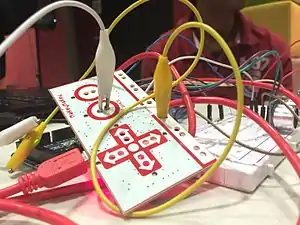Makey Makey
Makey Makey: An Invention Kit for Everyone is an invention kit designed to connect everyday objects to computer keys.[1] Using a circuit board, alligator clips, and a USB cable, the toy uses closed loop electrical signals to send the computer either a keyboard stroke or mouse click signal. This function allows the Makey Makey to work with any computer program or webpage that accepts keyboard or mouse click.

Product background
MIT students, Jay Silver and Eric Rosenbaum, the Makey Makey was produced by research done at MIT Media Lab's Lifelong Kindergarten.[2] Prior to creating the Makey Makey, Jay Silver and Eric Rosenbaum also worked on creative tools and invention kits such as Drawdio,[3] Singing Fingers,[4] and Scratch.[5]
The first prototype for Makey Makey was created in 2010 and tested at a workshop at San Francisco Exploratorium where participants used the product to create a game called "Drum Pants" that used a beach ball as a controller and water buckets as the foot-pads to play the console game, Dance Dance Revolution.[6] The Second Prototype was created in 2011 and 2012 and tested with interactive design specialists, after which the final prototype was tested at the Maker Faire in San Francisco in 2012 before the end of the Kickstarter campaign.[7]
Funding
Makey Makey was started through a Kickstarter campaign that raised over $50,000. Following its initial funding on Kickstarter, Makey Makey was written about in Mashable,[8] Wired, and New Scientist,[9] among others.
Technical specifications
The Makey Makey board[10] was originally designed around the Atmel 32U4 microcontroller.[11] The controller uses all 12 analog input pins on the 32U4 microcontroller in combination with a pull-up resistor array to sense the low voltages returning from conducting materials like fruit or skin. This microcontroller can easily be used as a USB-HID device and act as a keyboard, gamepad or mouse. The hardware design is very similar to the Arduino Leonardo,[12] with some added pull-up resistors and indication LED's. Because of the similarities you can easily turn a regular Arduino Leonardo into a Makey Makey compatible device.[13] You can also program the official Makey Makey using the Arduino IDE.[14] The REV 1.2 board[15] is built around the Microchip PIC 18F25K50.[16] With the REV 1.2 reprogramming the microcontroller is no longer possible,[17] and the functionality is now limited to keyboard and mouse emulation. REV 1.2 also drops the open source nature of the board design, and the new Makey Makey boards no longer can run stand-alone code. The newest 2017 version seems to be designed[18] around a GPCE4096UA sound controller.[19]
Awards and recognition
References
- MaKey MaKey - How would YOU interact with your computer? on YouTube
- Kottoor, Naveena (7 June 2012). "MIT students' invention turns bananas into keyboard". BBC News.
- "Redirecting to Drawdio". web.media.mit.edu.
- "Projects" (PDF). Eric Rosenbaum.
- "Scratch - Imagine, Program, Share". scratch.mit.edu.
- "Kickstarter invention kit turns bananas into pianos, dogs into spacebars, Wired (May 15, 2012)".
- Senese, Mike. "10 Insanely Cool Things We Saw at Maker Faire (Plus 5 Videos)". Wired.
- Erickson, Christine (June 2012). "Rejoice! Now You Can Use a Banana as a Keyboard". Mashable.
- "DIY circuit turns your alphabet soup into a keyboard".
- "Makey Makey - Standard Kit (Open hardware) - EasyEDA open source hardware lab". oshwlab.com.
- "Dynamic Product Page | Microchip Technology".
- https://www.arduino.cc/en/uploads/Main/arduino-leonardo-schematic_3b.pdf
- "DIY Makey Makey with Arduino Leonardo - Wikifab".
- "MaKey MaKey Advanced Guide - SparkFun Learn".
- "Makey Makey Classic Hookup Guide - SparkFun Learn".
- "Dynamic Product Page | Microchip Technology".
- https://www.sgbotic.com/products/datasheets/development/MakeyMakey_Comp_Chart.pdf
- Archived at Ghostarchive and the Wayback Machine: MaKey MaKey - Not very good, but at least it's expensive. YouTube.
- "GPCE4096UA Datasheet | Generalplus - Datasheetspdf.com". datasheetspdf.com.
- "MoMA - Welcoming New Humble Masterpieces into MoMA's Collection". www.moma.org.
- "The 10 Best Toys From The 2014 Toy Fair". 18 March 2019.